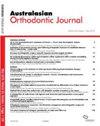微型支架支持的3D®上颌对称远距弓对第三磨牙上颌磨牙远距的影响
IF 0.9
4区 医学
Q4 DENTISTRY, ORAL SURGERY & MEDICINE
引用次数: 0
摘要
摘要目的:本研究的目的是研究第三磨牙对新型微型螺钉支撑的3D®上颌双径扩弓(3D-MBDA)的效率和生物力学的影响。方法:23名患者在治疗开始时拔除了第三磨牙(第1组,n=11)或保留了第三臼齿(第2组,n=12)。分析在上磨牙远端化开始(T0)和结束(T1)时拍摄的侧位头影测量片和牙模,以研究各组之间的差异。结果:两组第一磨牙牙冠远中位基本一致;然而,第1组在三叉和根尖水平上的牙根远端化、近中颊侧牙尖顶的侵入和远端化率均显著较高。与通常的远端倾斜不同,两组第一磨牙的倾斜方向均为近中方向。在第1组中,第二磨牙向远侧移动更多,前庭移位更少,并向近颊旋转,而在第2组中,它们表现出显著更高的前庭移位和双颊旋转。与第2组相比,第1组的平均远端时间明显更短。第1组和第2组的迷你船员成功率分别为95.5%和91.7%。结论:小螺钉支持的3D-MBDA对磨牙根远侧和最终倾斜度有较大的影响。第三磨牙与牙根移动受限、第二磨牙移位不利以及远端速率较慢有关。因此,建议在远端化前拔除第三磨牙,尤其是当迷你螺钉支持的3D-MBDA是矫治器的选择时。本文章由计算机程序翻译,如有差异,请以英文原文为准。
The effect of third molars on maxillary molar distalisation using a miniscrew-supported 3D® maxillary bimetric distalising arch
Abstract Objectives: The aim of the present study was to investigate the effect of third molars on the efficiency and biomechanics of a novel miniscrew-supported 3D® Maxillary Bimetric Distalising Arch (3D-MBDA). Methods: Twenty-three patients, whose third molars were either extracted at the beginning of treatment (Group 1, n =11) or retained (Group 2, n =12), were included in the study. Lateral cephalometric films and dental casts, taken at the beginning (T0) and at the end of upper molar distalisation (T1), were analysed to study the differences between groups. Results: Crown distalisation of the first molars was similar between the groups; however, root distalisation, both at the trifurcation and apex levels, intrusion at the mesiobuccal cusp tip, and the distalisation rate were significantly higher in Group 1. The resultant tipping of the first molars in both groups was mesially-directed, unlike the usual distal tipping. The second molars distalised more, displaced less vestibularly and rotated mesiobuccally in Group 1, whereas they demonstrated a significantly higher vestibular displacement and distobuccal rotation in Group 2. The mean distalisation time was significantly shorter in Group 1 when compared to Group 2. The miniscrew success rate was 95.5% for Group 1 and 91.7% for Group 2. Conclusion: The miniscrew-supported 3D-MBDA was found to have greater effects on root distalisation and the final inclination of the molars. The third molars were associated with limited root movement, unfavourable displacement of the second molars, as well as a slower distalisation rate. Therefore, the extraction of third molars prior to distalisation is recommended, especially when the miniscrew-supported 3D-MBDA is the appliance choice.
求助全文
通过发布文献求助,成功后即可免费获取论文全文。
去求助
来源期刊

Australasian Orthodontic Journal
Dentistry-Orthodontics
CiteScore
0.80
自引率
25.00%
发文量
24
期刊介绍:
The Australasian Orthodontic Journal (AOJ) is the official scientific publication of the Australian Society of Orthodontists.
Previously titled the Australian Orthodontic Journal, the name of the publication was changed in 2017 to provide the region with additional representation because of a substantial increase in the number of submitted overseas'' manuscripts. The volume and issue numbers continue in sequence and only the ISSN numbers have been updated.
The AOJ publishes original research papers, clinical reports, book reviews, abstracts from other journals, and other material which is of interest to orthodontists and is in the interest of their continuing education. It is published twice a year in November and May.
The AOJ is indexed and abstracted by Science Citation Index Expanded (SciSearch) and Journal Citation Reports/Science Edition.
 求助内容:
求助内容: 应助结果提醒方式:
应助结果提醒方式:


